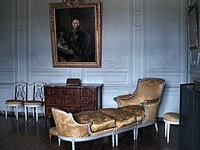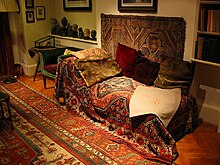


A chaise longue (/ʃeɪz ˈlɒŋ, tʃeɪz-, -ˈlɒ̃ɡ/; French: [ʃɛz lɔ̃ɡ], "long chair") is an upholstered sofa in the shape of a chair that is long enough to support the legs of the sitter.
In modern French, the term chaise longue refers to any long reclining chair, such as a deckchair.
In English, the term "chaise longue" is sometimes written as chaise lounge and pronounced /ˌtʃeɪsˈlaʊndʒ/, a folk etymology replacement of part of the original French term with the unrelated English word lounge. When English speakers imported a new kind of sofa from France in the late 1700s, they transformed the name 'chaise longue' ("long chair") into 'chaise lounge'—since 'lounge' is an English word spelled with the same letters and lounging is something one can do on a "chaise longue." This variant has been documented in British texts since at least 1811 and in American texts since 1824.
Origins
The modern chaise longue was first popularised during the 16th century in France. They were created by French furniture craftsmen for the rich to rest without the need to retire to the bedroom. It was during the Rococo period that the chaise longue became the symbol of social status and only the rarest and most expensive materials were used in their construction. Today, the chaise longue is considered a luxury item for the modern home. They are often used to complement a home's décor, such as living or reading rooms, or as stylish boudoir chairs for bedroom seating.
- Duchesse brisée (French: 'Broken duchess'): this word is used when the chaise longue is divided into two parts: the chair and a long footstool, or two chairs with a stool in between them. The origin of the name is unknown.
- Récamier: a récamier has two raised ends and nothing on the long sides. It is sometimes associated with French Empire (neo-classical) style. It is named after French society hostess Madame Récamier (1777–1849), who posed elegantly on a couch of this kind for a portrait painted in 1800 by Jacques-Louis David. The shape of the récamier is similar to a traditional lit bateau (boat bed) but made for the drawing room, not the bedroom.
- Méridienne: a méridienne has a high headrest and a lower footrest, joined by a sloping piece. Whether or not they have anything at the foot end, méridiennes are asymmetrical daybeds. They were popular in the grand houses of France in the early 19th century. Its name is based on its typical use: rest in the middle of the day when the sun is near the meridian.
-
 Chaise longue (Klinai) in a 4th-century Roman manuscript
Chaise longue (Klinai) in a 4th-century Roman manuscript
-
 Duchesse brisée
Duchesse brisée
-
 Récamier
Récamier
-
 Méridienne
Méridienne
Psychoanalysis

The chaise longue has traditionally been associated with psychoanalysis. Sigmund Freud initiated using the chaise longue for this purpose, the idea being that the patient would recline on a couch, with the analyst seated beyond the head of the couch, so that the client would not see the analyst. Reclining and not having to face the analyst was thought to be disinhibiting and encouraging free association. When Freud began to use the chaise longue, Viennese considered it daring to recline on a chaise in the presence of non-intimates. Freud's chaise longue, given to him by a patient, may be seen today at the Freud Museum in London.
Today, psychoanalysts invite clients to recline on couches in their offices during psychotherapy and may use chaises longues rather than more conventional styles of couches out of tradition. The chaise longue is commonly used as visual shorthand to suggest a generic psychotherapist's office in cartoons and other works.
See also
References
- ^ "Chaise longue". Dictionary.com. 2009-08-15. Retrieved 2017-04-04.
- "'Chaise Lounge' or 'Chaise Longue'?". Merriam Webster.
- "Google Books Ngram Viewer". books.google.com. Retrieved 2023-02-21.
- "Google Books Ngram Viewer". books.google.com. Retrieved 2023-02-21.
- "'Chaise Lounge' or 'Chaise Longue'?". www.merriam-webster.com. Retrieved 2023-02-21.
- "History of the chaise longue". The Chaise Longue Co. Retrieved 2019-07-31.
- ^ "Is a Recamier the Same as a Chaise Longue?". HammockStandPro.com. Archived from the original on 8 September 2017. Retrieved 26 June 2019.
- Cook, William (21 August 2006). "Analysing Freud's couch". The Guardian. Retrieved 23 May 2020.
- Blundy, Anna (16 June 2016). "Life of the mind: The importance of the couch". Prospect Magazine. Retrieved 23 May 2020.
External links
- Segal, Troy (23 April 2019). "All About American and European Daybeds". The Spruce Crafts, Dotdash. Retrieved 26 June 2019.